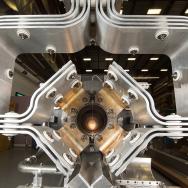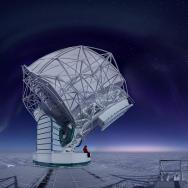In 2012, scientists and the public around the world rejoiced at the news that CERN’s Large Hadron Collider had discovered the long-sought Higgs boson—a particle regarded as a linchpin in the Standard Model of particle physics, the theory that describes the fundamental forces and classifies all known elementary particles.
Despite the breakthrough, subsequent collisions in the machine have yet to produce evidence of what physicists call “new physics”: science that could address the areas where the Standard Model seems to break down—like dark matter, dark energy and why there is more matter than antimatter. So now, the particle accelerator and its detectors are getting an upgrade.
On Feb. 5, the National Science Foundation and the National Science Board gave the green light for $75 million in funding for upgrades to the ATLAS experiment, one of the collider’s two 7-story high and half a football-field long detectors—opening the doors for the discovery of new particles and rare processes. Approximately $5.5 million will go to the University of Chicago, a founding member of the ATLAS experiment, to design and build several components for the upgraded detector.
“These upgrades will help the physics community answer glaring questions surrounding the structure of the fundamental particle universe,” said Asst. Prof. David Miller, a particle physicist who has worked extensively on the ATLAS detector and is co-leading the University’s participation in the upgrade. “Why do the fundamental particles that we know about exist in the first place? What is the underlying pattern and structure behind them?”
The upgrades, which are estimated for completion in 2026, will allow researchers to study the Higgs boson in greater detail; continue the hunt for dark matter, which comprises 25% of our universe and has never been directly detected; and identify new particles, interactions, and physical properties such as new symmetries or spatial dimensions.
“These upgrades will help the physics community answer glaring questions surrounding the structure of the fundamental particle universe.”
The upgrades to the LHC itself will increase its luminosity—the intensity of its proton beams—by a factor of ten, substantially increasing the number of particle collisions that occur in a given amount of time. Thus ATLAS detector, which is the “camera” capturing images of the collisions, must also be upgraded to filter larger quantities of data at high speeds and to deal with more intense radiation.
“The biggest challenge with our existing detector is separating the signal from the background. For every interesting particle you produce, there are probably something like a million standard particle decays that look about the same,” said Prof. Mark Oreglia, a renowned expert in collider research and development and the other leader for the project.
Researchers at the University of Chicago will build portions of the calorimeter, the system that measures the energy of the particles that enter the detector; and the trigger, which tells the detector what images, or “events” to record or ignore.
The challenge for the new calorimeter is building an instrument so sensitive it can instantaneously measure the light and energy coming off the 200 proton-proton collisions that will occur 40 million times per second—while also robust enough to withstand that same powerful radiation.
UChicago researchers already have built prototypes of some components and sent them for rigorous testing to ensure they could withstand the LHC’s increased intensity. Construction of electronics is slated to begin this spring, with undergraduate students participating in the testing of the boards to look for short circuits and other flaws.

Another challenge posed by the upgraded LHC is the volume of data produced by the collisions.
“In their raw form, the data volume is nearly one petabyte per second, so there’s no way we can save that amount,” Miller said. “We have to come up with clever ways to determine what to keep and what to throw away.”
Miller’s team is partnering with UChicago Computer Science faculty Assoc. Prof. Risi Kondor and Asst. Prof. Yuxin Chen, tapping their pioneering work in machine learning to develop innovative algorithms and software to tackle this unprecedented task.
“Machine learning helps us detect patterns in the data and uncover features that we might not otherwise have seen,” Miller said. “For example, I’m working with Risi Kondor to build a completely new type of neural network whose inherent structure reflects known symmetries of nature.”
The $75 million from the National Science Foundation will complement $163 million funding from the U.S. Department of Energy to support the upgrade to the detector. The project will involve multiple universities as well as national laboratories. ATLAS is a large international collaboration consisting of 3000 scientists from 182 institutions and 38 countries.
Additional researchers and groups involved with the construction are Young-Kee Kim, the Louis Block Distinguished Service Professor of Physics; Melvyn Shochet, the Kersten Distinguished Service Professor of Physics; and the staff of the Enrico Fermi Institute’s Electronics Development Group (EDG) and MANIAC Lab: EDG director Mary Heintz, EDG research professor Kelby Anderson, EDG engineers Mircea Bogdan and Fukun Tang, and MANIAC Lab director research professor Robert Gardner, who heads an NSF effort called Scalable Systems Laboratory to develop data processing systems for all of the data collected and to provide platforms for complex data analysis tasks.









